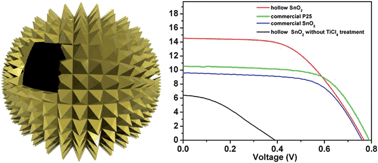Efficient conversion of solar energy to electricity is a dream we all share, in the natural world sunlight is the basis for nearly all life (excluding those deep see hydrothermal vents and chemo-autotrophic bacteria based communities!). If we could mimic this in our modern world, powering transport, industry and domestic environments with an environmentally friendly, abundant and free power source, we would surely be better off………….. but what’s the best way to do it?

SnO2 hollow nanospheres in DSSC's can give light-to-electricity conversion efficiencies of up to 6.02%
Dye sensitized solar cells (DSSC’s) have been an attractive prospect for some time now, they are relatively cheap and their light harvesting efficiency is dependent on dye absorption and charge separation. By designing hollow SnO2 nanospheres enclosed with single crystalline nanoparticles, Jinghong Li and Lin Guo et al. have achieved a light-to-electricity conversion efficiency of 6.02%, which is among the highest in non-TiO2 semiconductor oxides.
The nanostructure design means there is a very high surface area, allowing absorption of a great number of dye molecules, while the single crystalline structure has efficient charge separation properties. This design is proving to be a great candidate for future DSSC technologies…
SnO2 hollow nanospheres enclosed by single crystalline nanoparticles for highly efficient dye-sensitized solar cells
Hua Wang, Bo Li, Jian Gao, Ming Tang, Hongbin Feng, Jinghong Li and Lin Guo










